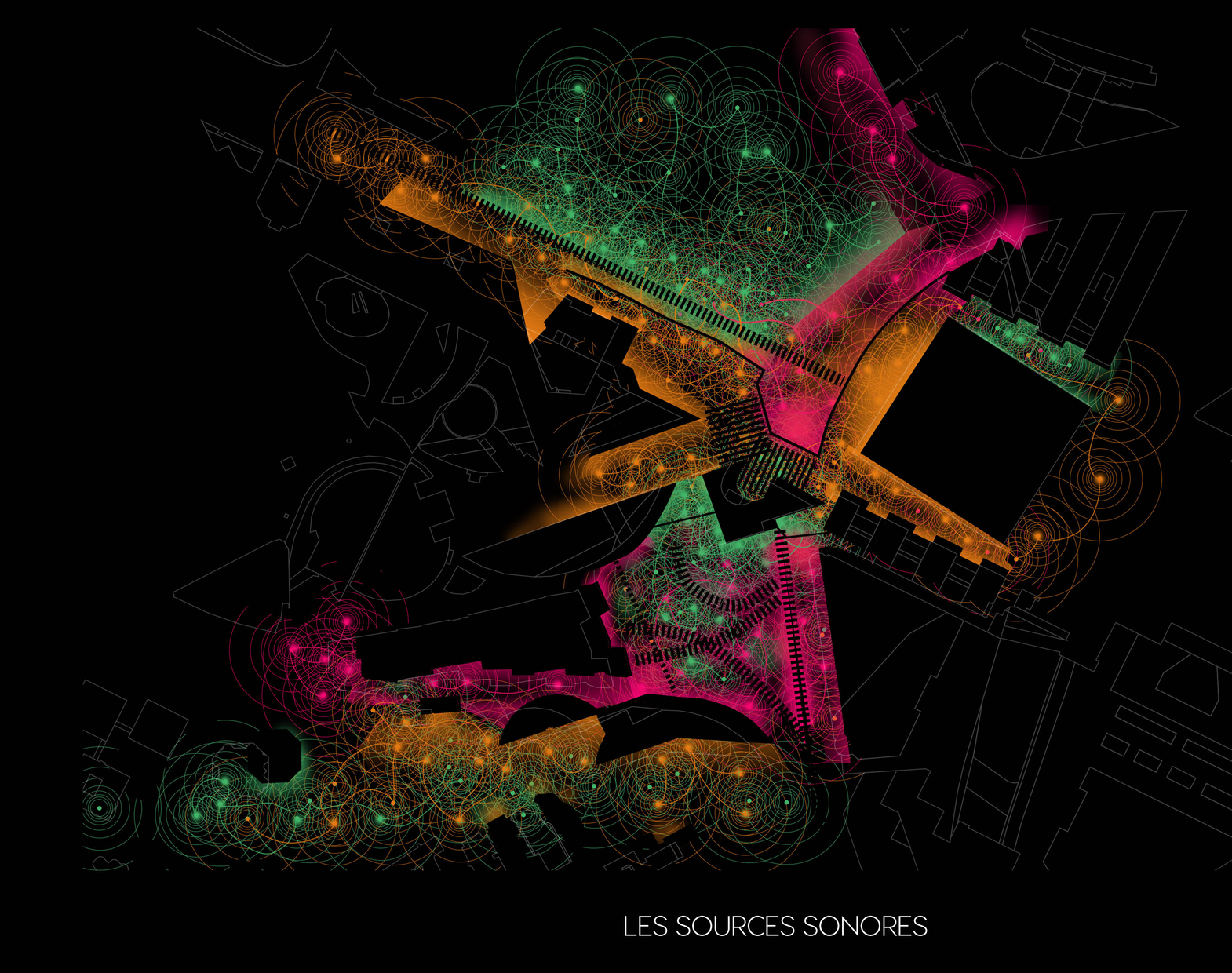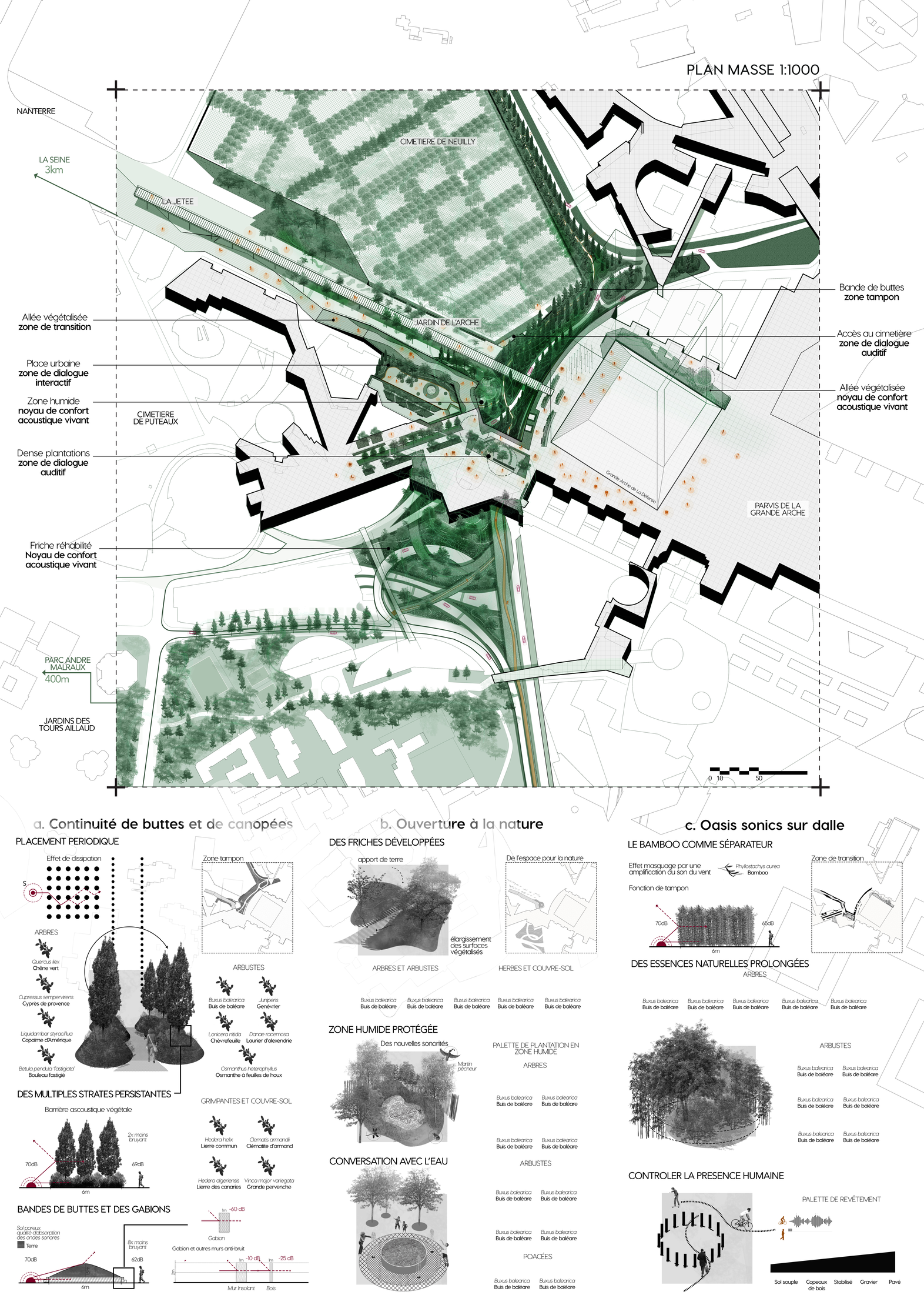Three colors draw the acoustic space of the Esplanade la defense, where each corresponds to a type of sound source. You can notice that on the center platform there is a strong presence of human sounds, in orange, and some points of presence of natural sounds which are in green. And we also see that all this sonosphere that makes up the center public space is surrounded by the pink soundwaves of mechanical sounds.
The district, founded on a network of transport infrastructure, the main source of noise pollution in an urban environment, is isolated from its territory by a ring of noise that is the boulevard circulaire. Its urban landscape makes up its own sonosphere composed by humans and machines where nature is out of tune. This acoustic obstacle accompanies the physical discontinuities and contributes to ecological imbalance.
The ambition of the project is to transform this noise obstacle that is the boulevard circulaire into an ecological interface and to compose urban "promenades", that are favorable to the presence of biodiversity. I approach the boulevard as a spatial interface with the ambition to transform it from an obstacle into an inclusive space of acoustic comfort and dialogue.
RE-ORCHESTRATING THE FLOWS - Territorial scale strategy
On a territorial scale, the study of sound is more a study of understanding the impacts, the sound alterations that contribute to the fragmentation of the urban environment. The previous understanding of the acoustic space in relation to the spatial typologies of La Defense allowed me to get an understanding of the urban ecosystems’s dynamics and the human to nature to road infrastructure flows that animate it. I looked beyond the urban ruptures to have an understanding of the site based on the flows that animate it (El Samman, 2021).
Furthermore, in order to envision the ecological transformation of this urban island, a vision of the flows that I want to establish through the white infrastructure strategy was projected.
These acoustic flows become the cornerstone of my design strategy: they inform the decision-making process by deeply indicating human-nature-mechanical interfaces, and the re-orchestration of such flows becomes the center-point of white infrastructure design.
COMPOSING THE ECO-ACOUSTIC CITY - Focused scale strategy
Sound is a variable and ephemeral medium that needs to be interpreted at a human scale. The following white infrastructure strategy aims to let sound drive the project. It helps perceive a designs’ resulting dynamics and to project the impact that a project can have on the urban environment,on ecological and social levels.
1- Sonotopes identification
The first step consists of Identifying the existing landscape typologies of the site, as well as the ambiances that color its soundscape. This allows for the extraction of the sonotopes that characterizes each typology. This allows for different sectors to be defined based on common acoustic qualities of certain areas, and for potential sonic continuities and centralities to be defined.
2- Acoustic space analysis
Once the sectors are defined, zoomed perimeters are deduced and a site specific acoustic analysis can be established. This is done through the creation of descriptive, sound maps including the acoustic and spatial dimension, and perspective sonographies, sound maps consisting of the auditory dimension (El Samman, 2021), such as sound level mapping and sound sources spatial understanding. As a result of this, a general understanding of the quality of the overall acoustic space is made visible. The latter is further on used to develop the white infrastructure strategy.
Designing soundscapes is a process that is done through basic landscape design with an extra acoustic lens to guide the design thinking process. Through my research, I explored how this could contribute to each of the phases of landscape designing on different scales.
What follows poses the 3 general stages to progressively develop a landscape project defined by a comfortable soundscape. I will illustrate these main points with maps and drawings from my exploration on La Defense.
DECIPHERING THE ACOUSTIC LAYERS - Site analysis
Based on sound surveys of sound levels, amplitudes and sources on the site, I have illustrated in the following video the resulting acoustic space of La Defense.
3- White infrastructure strategy at site scale
As previously concluded, white infrastructure is a work of balancing sound sources. This process is done by placing nature's voice as a priority, human sounds in the second step and mechanical sounds in the third in a way that the modern urban design spatial and acoustic layering is reversed.
Hence, the first step consists of eliminating and reducing noise pollution created by road infrastructure from public space’s sonosphere.
The second step consists of preserving the mapped existing acoustically comfortable zones where nature is prosperous and to amplify the sonorities of these areas.
This preservation of the healthy soundscapes is enhanced by the rethinking of the ecotones that lies between them and the human dominated soundscape. As previously mentioned, human dominated soundscapes can disturb the existence of the non-human beings in urban ecosystems. This leads us to the third step, which consists of balancing the transition between human and non-human dominated soundscapes in a way that they coexist and interact without one overpowering the other.
4- Acoustic actions
To achieve the desired spatial sonic organization, practical acoustic actions must be defined.
This process consists of creating a zoning plan with the following actions defined: creation of a buffer zone, of a zone of transition or of dialogue in between the micro-sonotopes envisioned, noise treatment and reduction area, etc. This dictates the sounds that should be attenuated, masked, amplified or re-composed.
5- Landscape actions
The acoustic actions map is then materialized into landscape actions. This means the questioning of the sonic effects of each design decision made, from the choices of the hard and soft palette to the spatial design layout organization. “What is the effect of having paved pathways, does this contribute to amplifying human sounds? How can I add natural sounds? What type of plants should I use to achieve the best buffer results in the space limit I have?” These are all examples of questions that can be asked at this stage. It is necessary here to know that every small decision has a sonic impact as each landscape element is a musical tool for composing the city.
Some of the most evident tools are the following:
- The modeling of topography based on desired sound obstruction or amplification.
- The densification plant covers for a buffer effect and the choice of a persistent plant palette with bigger texture, to maximize surface area of reflected sounds.
- The usage of sound absorbing pavers for a less impactful stepping sounds.
- The land use and spatial planning.





